Happy Chinese New Year! The Secret Chinese Menu. Hop Woo BBQ. Chinatown, Los Angeles.

Secret chicken soup.
Call me the Julian Assange of secret Chinese restaurant menus. I eat and I leak. Did that come out right?
It's widely suspected that there are at least two menus in a Chinese restaurant: the one for them and the one for us. The question is: Are you with "them" or "us"?
And I'm not talking about the In N' Out Burger kind of secret menu with merely unlisted variations of their burgers. No, I'm talking seriously secret menu.
Usually, when you stroll into a real Chinese restaurant (read: not Panda Express, PF Chang or the Cwazy Wok!), you'll be given the standard English/Chinese language menu that the waitstaff hands to their customers once seated.
However, if you request the Chinese language only menu, you'll be privy to dishes not found on the "regular" menu, though you'll need to be able to decipher the Chinese characters printed within. If you can't read Chinese, then bring a friend who can read it or at least speaks it, otherwise you're at risk for getting straight up "whited".
Chef Lupe Liang of Hop Woo BBQ in LA's Chinatown admits one reason he has a Chinese menu is because he doesn't want to frighten or gross out any of his squeamish clientele, regardless of race. Another reason is that if he put all of his items on one menu, it would read like the Yellow Pages (no racial pun intended) or the big ass menu at Jitlada.
Once you're in, you're in. You're one of us. The maître d', the waitstaff and, most importantly, the chef will know your gastronomic predilections. You see, it's not at all about what you look like, where you're from or what language you speak, it's about what you're willing to put in your mouth.
Suddenly you're through the looking glass and a whole new world of culinary adventure opens up. Some of these dishes are unusual and delicious while others can be kitchen nightmares.
One of the odd bites offered in Hop Woo's Chinese menu is a chicken soup with Traditional Chinese Medicine herbs and roots. Punctuating its chicken-ness is a single chicken foot sans talons. The broth is rich with chicken flavor but even more so with the distinct sapor of a Chinese herbal shop, which is that of savory medicine.
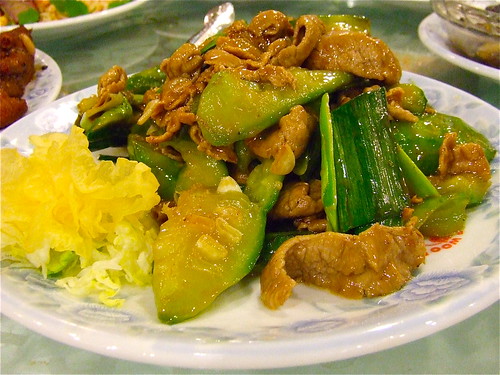
Deer, the other red meat.
The visually appealing and delicious plate of deer meat would probably be the most pedestrian entrée of the night. Hop Woo's Deer Meat with Star Melon and Leeks showcased deer perfectly in a simple Chinese stir-fry. It's leaner and more delicate in flavor than beef, and it's organic the old fashioned way. The leek's powerful pungency and the star melon's fresh cucumber flavor balanced out this tasty dish.
If the great flavors alone aren't enough, then maybe its healthful benefit for women, skin and blood circulation will convince you of its honorable effects as good food.
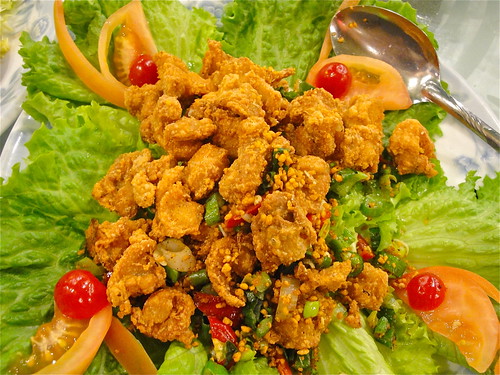
I'm a knee man.
Of all the edible parts on a chicken to ingest, eating the knee is really pushing it. For the majority of the planet, that little bit of cartilage is hardly food. But, place that avian scrap into the hands of a chef like Lupe Liang and it becomes tasty chicken fried knee.
Encased in a spicy-salt batter, topped with bits of fried garlic and piled up like popcorn, these tiny knees are completely edible with the cartilage and trace amounts of meat yielding satisfyingly. It's a fairy tale wedding of crunchy and chewy textures. No bones to contend with. The spicy-salt crust will inspire the perfect pronunciation of "Tsingtao" as you seek desperate refuge in a cold one. The garlic taste will mercifully leave your mouth in time for Valentine's Day.
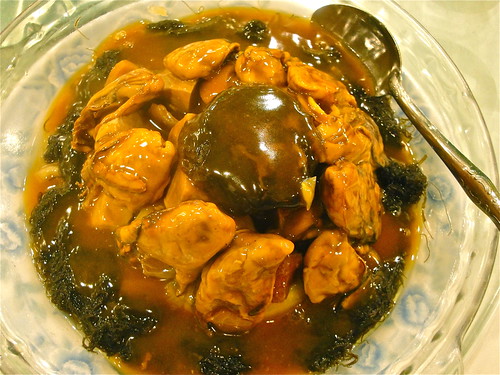
Hairy oyster.
If you have a thing about textures, in other words, you don't like weird mouthfeel. You best pass on the Dried Oysters with Hair Vegetable. I, however, enjoyed this most gelatinous of dishes with its brown sauce shellacking the shiitake mushroom on top to the "hair vegetable" surrounding the oysters. The dried oysters have been reconstituted several times to regain most of their original size. In the process, it achieves a fine smoked flavor.
And then there's the "hair vegetable". While most diners would complain about hair in their food, not the Chinese. Well, only if that "hair" was the desirable "hair vegetable" or hair moss. This vegetable is actually a blue-green algae and is sometimes used in Chinese cooking.
When spoken in Chinese, hair vegetable is also a homophone for "good fortune". In Mandarin, hair is pronounced "fah" and vegetable is pronounced "tsai". Good fortune, in Mandarin, is pretty close to those two words put together, barring slight differences in tone. Thus, the idea being hair vegetable brings good fortune, hopefully, even a thick head of hair.
Its texture is unique and feels sorta like hair, then it quickly dissolves on the tongue. The flavor is algae-like but mostly masked by the savory-salty sauce.
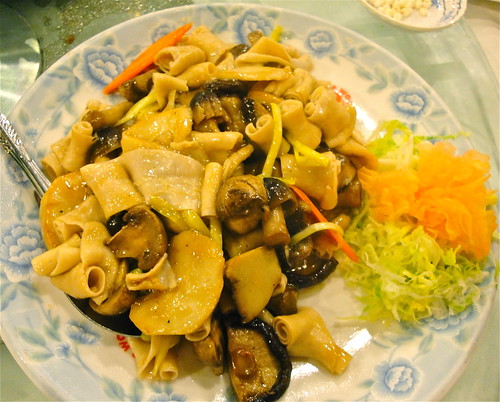
Goose guts.
What is it about goose guts that make people want to pay premium prices? Foie gras from goose fetches a nice sum we all know, but how about goose intestines? For offals, it's not cheap. It'll set you back about $16 a pound wholesale.
Each scroll of goose intestine possesses a singular chewiness, almost rubbery texture and is nearly void of flavor. The taste is largely from the Shaoxing wine, ginger and green onion. The other pleasant portion is made up of a mushroom quartet including white button, straw, shiitake and "chicken drumstick".
This luxury delicacy is also a homophone food favored during Chinese New Year. The word intestine is "tsong" in Mandarin. Long in Mandarin is also pronounced "tsong". Long is a popular word during the New Year because of all the well wishes for long life and long prosperity. See, we all can get a "long".
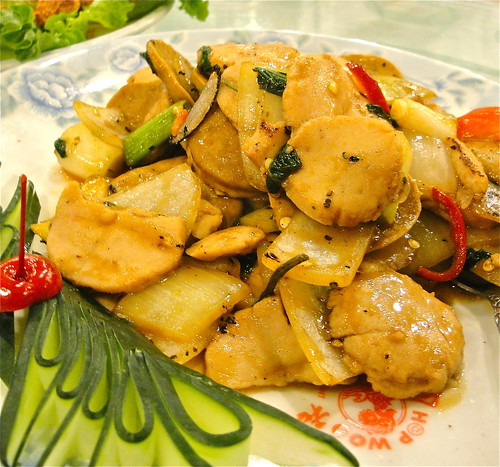
Lamb "eggs". Not scrambled.
Here's a little secret when ordering off the secret menu: if you're lusting for lamb testicles, ask for Lamb Eggs. Don't say lamb balls, fries or mountain oysters. Eggs is what the Chinese menu calls them.
Yes, they're called "eggs" but don't request them scrambled, sunny side up or over easy. Chef Liang fries up those sheep scrotes in a hot wok until fragrant and slightly nutty.
These thinly sliced lamb eggs come in two textures depending on how mature the lamb's nuts were. The pair will either be soft and spongy if young or firm and chewy if more mature. Regardless of texture, the lamb eggs have a slightly gamy and livery flavor. Yellow onions, red bell pepper, red pepper, green onion and fried basil give this otherwise bland dish some balls. Apparently, it can give you some balls too. If you're a guy, it purports to be a natural Viagra and aphrodisiac. That's probably more information about ingesting lamb sack than you'll ever need to know in this lifetime.

Armored armadillo soup.
As we go from soup to nuts, I mean, nuts to soup, Hop Woo's most exotic soup was presented in a humble ceramic single serve pot. Essentially another Traditional Chinese Medicine style soup, however, this special broth incorporated the armored animal known as an armadillo. Yes, armadillo.
The most distressing aspect about eating an armadillo is the idea that it may be infected with mycobacterial leprosy. Yes, leprosy. However, the University of Georgia Center for Urban Agriculture calls the armadillo flesh "tasty and eaten often by people." As long as the raw flesh is handled carefully and the meat is cooked thoroughly will any risk be eliminated. Moreover, not all armadillo carries the disease. Usually it's only the wild ones that have it.
Okay! Now that's settled, how was this armadillo soup? Much like the chicken foot soup, the armadillo version had that same Chinese herbal shop essence with various herbs and roots. But, the broth's deep, rich beefy flavor contrasted with the delicate armadillo meat which itself was very chicken-like. The bits of meat were quite small and attached to bone. A few swaths of the armor floated about the broth like medieval garnish. Small chunks of pork augmented the armadillo protein.
Believe it or not, there are benefits to eating armadillo according to some: enhanced blood circulation, relief of lower back pain and it's good for the kidney. And, of course, if you're a dude, it has Viagra-esque effects.
That said, the thought of contracting leprosy hung in the air heavily like an armadillo's ghost. As terrified as I was, it was still very good. It was armadallicious even.
Congratulations! Welcome to the world of the secret Chinese menu. It's as far removed from sweet and sour chicken as you can possibly get. The next time you go to a real Chinese restaurant, you'll know a little something that others in the dining room might not. You may now wish that you never knew. Too late. That's the rub about secrets, you can't unlearn them. You can, though, decide whether or not to take advantage of them. Besides, this secret is different. This one can be delicious, if you want it to be.
But, remember, it's our little secret.
Hop Woo BBQ Restaurant
845 North Broadway
Los Angeles, CA 90012-2309
213.617.3038
ALSO, PLEASE CLICK LINK TO LISTEN TO THIS STORY ON THE MADELEINE BRAND SHOW!
Comments
Heard you on NPR, think you should be less timid about our food culture. Just because it's Chinese doesn't mean we all like it, likewise for anybody else and their food. Be proud of it, it's unique.
Although I very much appreciate your comment, I don't agree that these dishes are "hardly deep end" because the exotic status of any given food is 100% relative to the person doing the eating. You may find everything on this blog not bizarre at all, which I'd say makes you a diner with a broad palate and open to cuisine of all sorts.
Much of the population in the U.S. would consider the few things listed in this particular post, unusual and may not want to eat all of them.
Each country, region, state or city has their own eccentric or not-so eccentric food specialties and one either appreciate them or not. And it's either weird or normal or neither.
Essentially what I'm saying is that strange food is all in the mouth of the eater. It's interpretation and it's totally relative to one's upbringing, experiences and willingness to try different and new foods.
Also you commented "...think you should be less timid about our food culture. Just because it's Chinese doesn't mean we all like it, likewise for anybody else and their food. Be proud of it, it's unique."
I'm not sure what you mean by all that, but I don't think I'm timid at all about food culture. If you think that, then I invite you to dig into the Deep End Dining vaults. There's no timid in much of my posts. I don't understand what you mean by the "just because it's Chinese doesn't mean we all like it" thought. I never claimed everyone should like Chinese food or any other food.
Then you tell me to "Be proud of it (Chinese food, I'm guessing), it's unique." So be proud of Chinese food because not everyone likes it? You need to clarify your seemingly disjointed statement.
Anyway, thanks for the comment.
If the asians do it in asia, that is fine with me. They can eat dogs, cats, after-birth, and each other, for all I care.
BUT, when they bring their filthy habits to MY country, the United States of America, it offends -- it sickens -- and if increases my dislike (if not hatred) for asians in general.
We Americans do NOT need to be exposed to the filthy eating habits of the asians.
And we do NOT need the likes of YOU to promote such filthy eating habits (are you still savoring your "wife's placenta"?)
Filthy people.
Shut the fuck up.
And btw I was trying to point out that cultures that are still relatively connected to their food source would have more respect for the things they eat, and other people eat. So in that sense, just cus I don't eat it doesn't mean I have to look at something with derogatory eyes. I've never had rocky mountain oysters, aka cow testicles, or scandinavian rotten fish, or gotten a turtle out of the pennsylvanian swamp and eaten that, but I'll try them.
The point of sharing food as a rite of hospitality going back in time is that food becomes a part of the body, so by sharing it, we've become one and the same. It's a positive unifying force. So yeah I'll try them. And if I don't like it, I don't like it, they get to laugh, there's no hard feelings.
Colon Ken is in serious need of a brain enema. There's something rotten plugged up in there.
Let the 'colonel' stick to his Kentucky Fried GM Chicken and Hungry Man meals
:)
Oh, yeah, and double shut the fuck up to Colonel Trotter...